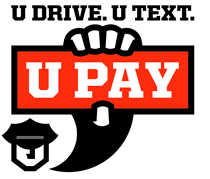Law Enforcement Joins National Anti-Texting Effort to Save Lives
From April 10 to 15, 2015, law enforcement personnel will be using a combination of traditional and innovative strategies to crack down on motorists who text while driving. This effort is a part of the national U Drive. U Text. U Pay high-visibility enforcement campaign that combines intense enforcement of anti-texting laws with advertising and media outreach to let people know about the enforcement and convince them to obey the law.
“Driving and texting is illegal and irresponsible. People who break State’s texting law should be
stopped and fined. If you drive and text, you should pay big, For those who say that driving and texting is an epidemic, we believe enforcement of state texting law is part of the cure.”
In 2013, 3,154 people were killed and an estimated additional 424,000 were injured in motor vehicle crashes involving distracted drivers. This represents a 6.7 percent decrease in the number of fatalities recorded in 2012.
According to a 2014 special article in the New England Journal of Medicine, the risk of a crash or near-crash among novice drivers increased with the performance of many secondary tasks, including texting and dialing cell phones.
The University of Michigan’s Transportation Research Institute’s 2012 “Teen Driver Distraction Study” reports that a quarter of teens respond to a text message once or more every time they drive, and 20 percent of teens and 10 percent of parents admit that they have extended, multimessage text conversations while driving.
“Texting and driving requires motorists to take their eyes off the road, hands off the wheel, and mind off the task of driving. It creates the proverbial ‘perfect storm’ for a crash, and no one has the right to put another person’s life at risk like that,”
 The successes of the Click It or Ticket and Drive Sober or Get Pulled Over campaigns have proven that the combination of tough laws, targeted advertising, and high-visibility enforcement can change people’s risky traffic safety behaviors. This strategy was implemented as part of the Phone in One Hand. Ticket in the Other distraction demonstration effort in Hartford, Connecticut, and Syracuse, New York, in 2010 and 2011, and then to Delaware and Sacramento County in 2012 and 2013. In both projects, texting (and cell phone use) declined dramatically.
The successes of the Click It or Ticket and Drive Sober or Get Pulled Over campaigns have proven that the combination of tough laws, targeted advertising, and high-visibility enforcement can change people’s risky traffic safety behaviors. This strategy was implemented as part of the Phone in One Hand. Ticket in the Other distraction demonstration effort in Hartford, Connecticut, and Syracuse, New York, in 2010 and 2011, and then to Delaware and Sacramento County in 2012 and 2013. In both projects, texting (and cell phone use) declined dramatically.
Based on these encouraging results, the U.S. Department of Transportation developed the U Drive. U Text. U Pay national campaign. The U Drive. U Text. U Pay campaign is national in scope, and has qualified for and received approximately $8.4 million in grant funding from the U.S. DOT to support this and other efforts designed to fight distracted driving. “It’s not that complicated: if you text and drive, you should be pull you over, and fined.
- As of January 2015, 44 States, DC, Puerto Rico, Guam and the U.S. Virgin Islands ban text messaging for all drivers. All but 5 have primary enforcement.
- An additional 4 States (MO, MS, OK, TX) prohibit text messaging by novice drivers.
- Three States (MS, OK, TX) restrict school bus drivers from texting.
- According to the latest data from NHTSA, nationwide in 2013, 3,154 people were killed and an estimated additional 424,000 were injured in motor vehicle crashes involving distracted drivers. This represents a 6.7 percent decrease in the number of fatalitiesrecorded in 2012.
- Distracted driving is any activity that diverts a person’s attention away from the primary task of driving. All distractions endanger driver, passenger, and bystander safety.
- Because text messaging requires visual, manual, and cognitive attention from the driver, it is by far one of the most alarming distractions.
- According to a study by the Virginia Tech Transportation Institute (VTTI), sending or receiving a text takes a driver’s eyes off the road for an average of 4.6 seconds, the equivalent of driving blind at 55-mph for the length of an entire football field.
- According to another NHTSA study (the 2012 National Occupant Protection Use Survey on Driver Electronics Use), at any given daylight moment in 2012, an estimated 660,000 drivers were using hand-held cell phones.
- According to a 2014 special article in the New England Journal of Medicine, the risk of a crash or near-crash among novice drivers increased with the performance of many secondary tasks, including texting and dialing cell phones.
Put the Phone down, your not that important!
For more information, please visit www.distraction.gov

You must be logged in to post a comment.